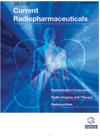- Home
- A-Z Publications
- Current Radiopharmaceuticals
- Issue Home
Current Radiopharmaceuticals - Current Issue
Volume 18, Issue 2, 2025
-
-
An Analysis of the Radiosensitiser Applications in the Biomedical Field
More LessBackgroundVarious types of radiosensitisers have been introduced from the past until the present day for applications in the biomedical field. However, there is a lack of understanding and comparison between the various parameters introduced in addition to a lack of consensus among researchers on the optimal radiosensitiser for applications in the biomedical field.ObjectiveThis review aimed to investigate the usage of Read More
-
-
-
Enhancing Ketoprofen Solubility: A Strategic Approach Using Solid Dispersion and Response Surface Methodology
More LessAuthors: Devika Tripathi, Dinesh Kumar Sharma and Jagannath SahooBackgroundIn the pharmaceutical sciences, the solubility profile of therapeutic molecules is crucial for identifying and formulating drugs and evaluating their quality across the drug discovery pipeline based on factors like oral bioavailability, metabolic transformation, biodistribution kinetics, and potential toxicological implications. The investigation aims to enhance the solubility parameters of ketoprofen (BCS-II class) Read More
-
-
-
Pressed Solid Target Production of 89Zr and its Application for Antibody Labelling
More LessAuthors: Anjli Shrivastav, Sonu Maurya, Manish Dixit, Sarita Kumari and Sanjay GambhirObjectivesZirconium-89 (89Zr, t1/2=3.27d) is an important β+ emitting radionuclide used in Positron Emission Tomography (PET) immuno studies due to its unique characteristics and increased demand due to simple and cost-effective production capacity. Production of 89Zr is achieved primarily through solid natural yttrium targets via different target preparation methodologies, such as electrodeposition, pressed foils, a Read More
-
-
-
Preclinical Aspects of [89Zr]Zr-DFO-Rituximab: A High Potential Agent for Immuno-PET Imaging
More LessBackgroundAn early diagnosis of cancer can lead to choosing more effective treatment and increase the number of cancer survivors. In this study, the preparation and preclinical aspects of [89Zr]Zr-DFO-Rituximab, a high-potential agent for PET imaging of Non-Hodgkin Lymphoma (NHL), were evaluated.MethodsDFO was conjugated to rituximab monoclonal antibody (mAb), and DFO-rituximab was successfully labeled with zirco Read More
-
-
-
Left Ventricular Wall Motion as an Additional Valuable Parameter in Diabetic Patients with Normal Myocardial Perfusion Imaging
More LessBackgroundGated SPECT is an established technique for assessment of left ventricular function in cardiovascular disease patients. However, there is little information about the influence of diabetes mellitus on gated SPECT parameters. This study was established to assess gated SPECT parameters in Diabetes Mellitus (DM) and non-diabetes mellitus (non-DM) patients with normal Myocardial Perfusion Imaging (MPI).Meth Read More
-
-
-
Apigenin's Influence on Inflammatory and Epigenetic Responses in Rat Lungs After Radiotherapy
More LessIntroductionThe lung is a moderately radio-sensitive organ. When cells are damaged due to accidental radiation exposure or treatment, they release molecules that lead to the recruitment of immune cells, accumulating inflammatory cytokines at the site of damage. Apigenin (Api) is a natural flavonoid known for its anti-inflammatory properties. In this study, we investigated the radioprotective properties of Api in the lu Read More
-
Volumes & issues
Most Read This Month Most Read RSS feed
Article
content/journals/crp
Journal
10
5
false
en


